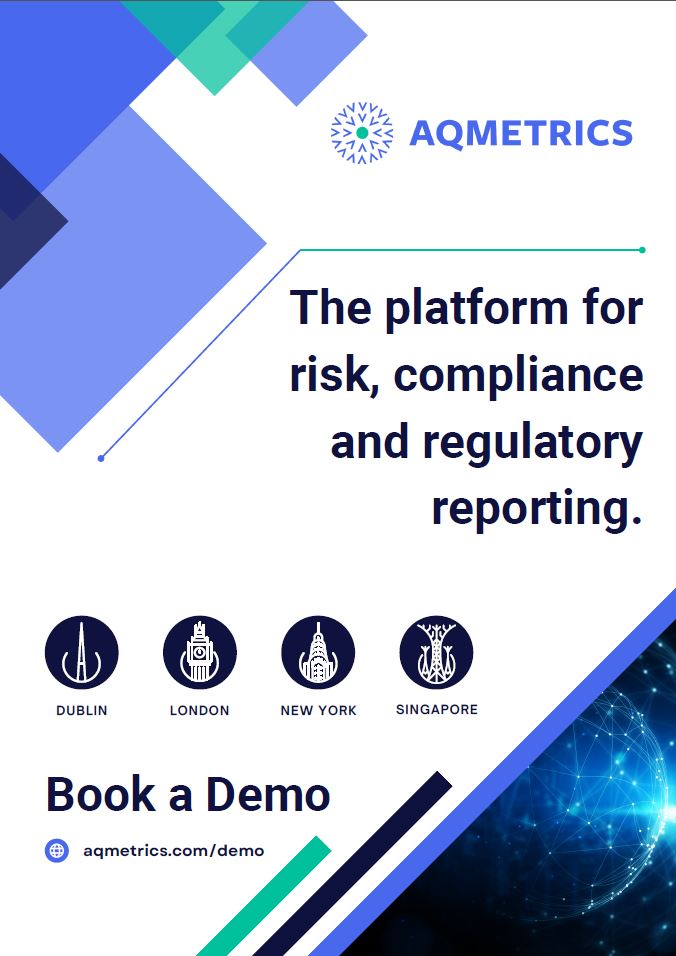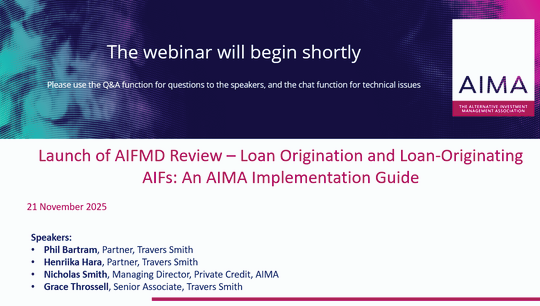Beyond alternative investment fund compliance: Navigating the complexities of risk monitoring
By Geraldine Gibson-Dautun, AQMetrics
Published: 18 March 2024
Evolving regulations, complex investment strategies, diverse asset classes, and the need for real-time oversight can turn investment monitoring into a complex task for any alternative investment fund (AIF). The dynamic nature of financial markets and the constant changes in regulatory requirements make it difficult for AIFs to ensure they are continually monitoring the right things. Additionally, the data and transactions involved require sophisticated systems and continuous vigilance to detect and address potential investment risks effectively.
Unlike Undertakings for the Collective Investment in Transferable Securities (UCITS) or 40 Act Funds, AIFs do not have to adhere to strict regulatory constraints, such as investment restrictions and risk diversification rules. AIFs are subject to the Alternative Investment Fund Managers Directive (AIFMD) in the European Union and to Securities and Exchange Commission (SEC) rules for Private Funds in the USA, but they generally have more flexibility in their operations and investment approaches compared to UCITS funds. AIFs are not yet concerned with harmonising compliance across multiple jurisdictions and adapting to different regulatory landscapes. That indeed may come with more SEC regulations and AIFMD2 in Europe but for now, AIFs focus is on investment risk monitoring rather than investment compliance monitoring.
AIFs have a broader scope for investment strategies than UCITS, Mutual Funds and Money Market Funds (MMFs) and can include a wider range of asset classes, including alternative and illiquid investments. AIFs often cater to professional or sophisticated investors who are willing to take on higher risks. With higher risks comes a need for enhanced risk monitoring and management. AIFs, given their broader investment scope, may engage in more complex and less liquid strategies. It is for this reason that risk monitoring for AIFs is less about compliance monitoring per se. AIFs risk management focuses on the specific risks associated with alternative investments, including valuation challenges and potential illiquidity issues. This heightens the need for robust risk management frameworks and reporting structures tailored to the specific nature of alternative investments.
AIFM risk monitoring in Europe compared to the USA
Further, investment monitoring for alternative funds in the USA and Europe differs due to variations in regulatory frameworks, legal structures, and market practices. In the USA the regulatory landscape includes both federal and state-level regulations, with the SEC playing a significant role. In Europe, the AIFMD governs alternative funds. This directive provides a harmonised framework across the European Union for the regulation of alternative investment fund managers and their funds.
The SEC emphasises the importance of effective risk management and valuation practices for alternative funds. Managers are required to have robust systems to value assets and manage risks. In Europe, AIFMD mandates that AIFs implement risk management processes and establish proper valuation procedures, including independent valuations for certain assets.
While there are overarching principles, the nuances in regulatory approaches and specific requirements highlight the importance of understanding the multi-jurisdictional landscape and local regulatory environments when it comes to investment monitoring for alternative funds in the USA and Europe.
Being independent of portfolio management, investment risk monitoring enables appropriate corrective actions when needed, such as currency or interest rate hedging, or monitoring more closely the evolution of certain risk exposures. Notwithstanding, monitoring and measuring risks associated with private equity and real estate investments as well as their evolution is a live issue for funds in both the USA and Europe.
Liquidity risk monitoring of hard-to-value securities
Illiquid or hard-to-value assets are common in AIFs. Mechanisms for fair value determination and dealing with complex securities are challenging for AIFs. The lack of quantitative data and the illiquidity of alternative investments make a risk measurement framework challenging for AIFs. Quantitative risk indicators such as changes to exchange rates and interest rates, microeconomics such as tenant default rates and rent hikes and macroeconomic indicators including GDP growth and inflation rates help risk monitoring, but capturing all material risks of private equity and real estate funds and proper monitoring of the same requires going beyond key risk indicators. Some risks lie within the valuation process and important factors such as discount rates require close monitoring. It is for this reason that advanced risk modelling techniques enable AIFs to combine the various risk indicators to derive an assessment and monitoring of risk through estimated distributions of internal rates of return (IRR) over a given time horizon.
This certainly helps when an AIF has to focus on liquidity risk measurement and control. A software solution must be able to independently determine value in portfolios containing hard-to-value securities is a must when it comes to integrating a comprehensive and robust risk monitoring framework that includes liquidity risk and valuation of hard-to-value securities.
Scenario analysis and stress testing
Scenario analysis and stress testing capabilities are essential. Software should enable AIFs to model different market scenarios and assess the potential impact on the portfolio and liquidity buckets, helping them make informed decisions. Stress testing requirements introduced by the AIFMD in Europe and SEC liquidity rules in the USA are a challenging factor for many private equity and real estate managers. Stress testing can leverage work already performed in the valuation of private equity or appraisal of real estate properties, by taking a forward-looking view. This can result in the assessment of the impact of adverse scenarios on the NAV of the fund.
Choosing software for investment risk monitoring
So, what key factors should an AIF consider when selecting investment risk monitoring software? Firstly, the software must align with the unique characteristics of alternative investments. The software must support a diverse range of alternative asset classes, including private equity, hedge funds, real estate, commodities, and other non-traditional investments relevant to the fund’s strategy. Accommodation of fund-specific risk metrics, investment strategies, and reporting requirements is a must. Software flexibility is crucial to adapt to the dynamic nature of alternative investments. AIFs use many systems, including portfolio management, accounting, and reporting tools and the software for investment risk monitoring must be able to easily integrate and plug into these existing tools. Integration streamlines data flow, reduces the risk of errors and enhances overall efficiency.
Given the sensitivity of data across a myriad of integrated systems, the software an AIF selects for investment risk management must be equipped with robust security measures to protect against data breaches. Compliance with data privacy regulations is essential to ensure the confidentiality of sensitive information.
Tracking exposure limits and investment guidelines and staying up-to-date with evolving regulations is a challenge for AIFs already trying to gain alpha at all costs. Software must remain effective and efficient as the AIF expands its operations and assets under management. AIFs need an investment risk monitoring solution that can scale with the growth of the fund.
Key to AIFs is the reputation of the software vendor, their experience in the financial industry, and the level of customer support they provide. A reliable vendor with good support can be instrumental in addressing issues promptly. By carefully evaluating risk management software based on these criteria, alternative fund managers can enhance their ability to identify, measure, and manage risks associated with their unique investment strategies.
Disclaimer:
At AQMetrics, we provide a managed services platform that helps our clients address their most complex regulatory challenges. As a global software company, we bring multi-jurisdictional knowledge and high-quality technology to our clients.
This publication has been written in general terms and we recommend that you obtain professional advice before acting or refraining from action on any of the contents of this publication. AQMetrics accepts no liability for any loss occasioned by any person acting or refraining from action as a result of any material in this publication.
AQMetrics is a limited liability company registered in Ireland with registered number 518969. AQ Metrics Limited UK Branch is registered in the UK with registered number BR019692. AQ Metrics PTE. LTD is registered in Singapore (Company Registration No. 202118696H) and AQ Metrics Inc. (identification number 35-2569563) is a wholly owned U.S. subsidiary of AQ Metrics Limited.
© 2024 AQMetrics. All rights reserved.

Managers are required to have robust systems to value assets and manage risks.






